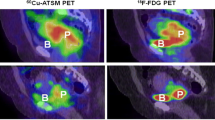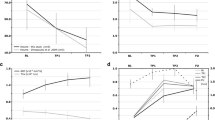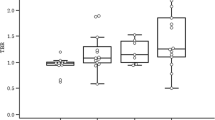Abstract
Purpose
To determine if hypoxia-related molecular markers are associated with 60Cu labeled diacetyl-bis (N 4-methylthiosemicarbazone); (60Cu-ATSM) imaging of tumor hypoxia in cervical cancer.
Procedures
Fifteen patients were enrolled in a prospective study and underwent evaluation of tumor hypoxia with positron emission tomography (PET) using 60Cu-ATSM. 60Cu-ATSM-PET imaging was compared with the expression of tissue molecular markers, which included vascular endothelial growth factor (VEGF), cyclo-oxygenase-2 (COX-2), epidermal growth factor receptor (EGFR), carbonic anyhdrase IX (CA-9), and apoptotic index.
Results
Six patients had hypoxic tumors determined by 60Cu-ATSM, and nine had non-hypoxic tumors. The 4-year overall survival estimates were 75% for patients with non-hypoxic tumors and 33% for those with hypoxic tumors (p = 0.04). Overexpression of VEGF (p = 0.13), EGFR (p = 0.05), CA-9 (p = 0.02), COX-2 (p = 0.08), and the presence of apoptosis (p = 0.005) occurred in patients with hypoxic tumors. Cox proportional hazards modeling demonstrated hypoxia as determined by 60Cu-ATSM to be a significant independent predictor of tumor recurrence (p = 0.0287).
Conclusions
60Cu-ATSM hypoxia was correlated with overexpression of VEGF, EGFR, COX-2, CA-9, an increase in apoptosis, and a poor outcome.

Similar content being viewed by others
References
Hockel M, Horn LC, Fritsch H (2005) Association between the mesenchymal compartment of uterovaginal organogenesis and local tumour spread in stage IB–IIB cervical carcinoma: a prospective study. Lancet Oncol 6:751–756
Graeber TG, Osmanian C, Jacks T, et al. (1996) Hypoxia-mediated selection of cells with diminished apoptotic potential in solid tumours. Nature 379:88–91
Ausserer WA, Bourrat-Floeck B, Green CJ, Laderoute KR, Sutherland RM (1994) Regulation of c-jun expression during hypoxic and low-glucose stress. Mol Cell Biol 14:5032–5042
Hanahan D, Folkman J (1996) Patterns and emerging mechanisms of the angiogenic switch during tumorigenesis. Cell 86:353–364
Loncaster JA, Cooper RA, Logue JP, Davidson SE, Hunter RD, West CM (2000) Vascular endothelial growth factor (VEGF) expression is a prognostic factor for radiotherapy outcome in advanced carcinoma of the cervix. Br J Cancer 83:620–625
Lee CM, Shrieve DC, Zempolich KA, et al. (2005) Correlation between human epidermal growth factor receptor family (EGFR, HER2, HER3, HER4), phosphorylated Akt (P-Akt), and clinical outcomes after radiation therapy in carcinoma of the cervix. Gynecol Oncol 99:415–421
Lopez-Ocejo O, Viloria-Petit A, Bequet-Romero M, Mukhopadhyay D, Rak J, Kerbel RS (2000) Oncogenes and tumor angiogenesis: the HPV-16 E6 oncoprotein activates the vascular endothelial growth factor (VEGF) gene promoter in a p53 independent manner. Oncogene 19:4611–4620
Dassonville O, Formento JL, Francoual M, et al. (1993) Expression of epidermal growth factor receptor and survival in upper aerodigestive tract cancer. J Clin Oncol 11:1873–1878
Kulkarni S, Rader JS, Zhang F, et al. (2001) Cyclooxygenase-2 is overexpressed in human cervical cancer. Clin Cancer Res 7:429–434
Gaffney DK, Holden J, Davis M, Zempolich K, Murphy KJ, Dodson M (2001) Elevated cyclooxygenase-2 expression correlates with diminished survival in carcinoma of the cervix treated with radiotherapy. Int J Radiat Oncol Biol Phys 49:1213–1217
Loncaster JA, Harris AL, Davidson SE, et al. (2001) Carbonic anhydrase (CA IX) expression, a potential new intrinsic marker of hypoxia: correlations with tumor oxygen measurements and prognosis in locally advanced carcinoma of the cervix. Cancer Res 61:6394–6399
Nunn A, Linder K, Strauss HW (1995) Nitroimidazoles and imaging hypoxia. Eur J Nucl Med 22:265–280
Rasey JS, Koh WJ, Evans ML, et al. (1996) Quantifying regional hypoxia in human tumors with positron emission tomography of [18F]fluoromisonidazole: a pretherapy study of 37 patients. Int J Radiat Oncol Biol Phys 36:417–428
Thorwarth D, Eschmann SM, Scheiderbauer J, Paulsen F, Alber M (2005) Kinetic analysis of dynamic 18F-fluoromisonidazole PET correlates with radiation treatment outcome in head-and-neck cancer. BMC Cancer 5:152
Fujibayashi Y, Taniuchi H, Yonekura Y, Ohtani H, Konishi J, Yokoyama A (1997) Copper-62-ATSM: a new hypoxia imaging agent with high membrane permeability and low redox potential. J Nucl Med 38:1155–1160
Lewis JS, McCarthy DW, McCarthy TJ, Fujibayashi Y, Welch MJ (1999) Evaluation of 64Cu-ATSM in vitro and in vivo in a hypoxic tumor model. J Nucl Med 40:177–183
Lewis JS, Sharp TL, Laforest R, Fujibayashi Y, Welch MJ (2001) Tumor uptake of copper-diacetyl-bis(N(4)-methylthiosemicarbazone): effect of changes in tissue oxygenation. J Nucl Med 42:655–661
Lewis JS, Herrero P, Sharp TL, et al. (2002) Delineation of hypoxia in canine myocardium using PET and copper(II)-diacetyl-bis(N(4)-methylthiosemicarbazone). J Nucl Med 43:1557–1569
Dehdashti F, Grigsby PW, Mintun MA, Lewis JS, Siegel BA, Welch MJ (2003) Assessing tumor hypoxia in cervical cancer by positron emission tomography with 60Cu-ATSM: relationship to therapeutic response—a preliminary report. Int J Radiat Oncol Biol Phys 55:1233–1238
Grigsby PW, Siegel BA, Dehdashti F (2001) Lymph node staging by positron emission tomography in patients with carcinoma of the cervix. J Clin Oncol 19:3745–3749
Perez CA, Brady LW (1998) Principles and Practice of Radiation Oncology, 3rd ed. Philadelphia: Lippincott-Raven
Grigsby PW (1999) Modification of the radiation response of patients with carcinoma of the uterine cervix. Cancer Control 6:343–351
Chiarotto JA, Hill RP (1999) A quantitative analysis of the reduction in oxygen levels required to induce up-regulation of vascular endothelial growth factor (VEGF) mRNA in cervical cancer cell lines. Br J Cancer 80:1518–1524
Laderoute KR, Alarcon RM, Brody MD, et al. (2000) Opposing effects of hypoxia on expression of the angiogenic inhibitor thrombospondin 1 and the angiogenic inducer vascular endothelial growth factor. Clin Cancer Res 6:2941–2950
Cheng WF, Chen CA, Lee CN, Wei LH, Hsieh FJ, Hsieh CY (2000) Vascular endothelial growth factor and prognosis of cervical carcinoma. Obstet Gynecol 96:721–726
Ueda M, Ueki M, Terai Y, et al. (1999) Biological implications of growth factors on the mechanism of invasion in gynecological tumor cells. Gynecol Obstet Investig 48:221–218
Laderoute KR, Grant TD, Murphy BJ, Sutherland RM (1992) Enhanced epidermal growth factor receptor synthesis in human squamous carcinoma cells exposed to low levels of oxygen. Int J Cancer 52:428–432
Kim HJ, Wu HG, Park IA, Ha SW (2003) High cyclooxygenase-2 expression is related with distant metastasis in cervical cancer treated with radiotherapy. Int J Radiat Oncol Biol Phys 55:16–20
Tran BN, Grigsby PW, Dehdashti F, Herzog TJ, Siegel BA (2003) Occult supraclavicular lymph node metastasis identified by FDG-PET in patients with carcinoma of the uterine cervix. Gynecol Oncol 90:572–576
Amit A, Beck D, Lowenstein L, et al. (2005, 2006) The role of hybrid PET/CT in the evaluation of patients with cervical cancer. Gynecol Oncol 100:65–69
Clavo AC, Brown RS, Wahl RL (1995) Fluorodeoxyglucose uptake in human cancer cell lines is increased by hypoxia. J Nucl Med 36:1625–1632
Burgman P, Odonoghue JA, Humm JL, Ling CC (2001) Hypoxia-Induced increase in FDG uptake in MCF7 cells. J Nucl Med 42:170–175
Levine EL, Renehan A, Gossiel R, et al. (1995) Apoptosis, intrinsic radiosensitivity and prediction of radiotherapy response in cervical carcinoma. Radiother Oncol 37:1–9
Kim CY, Tsai MH, Osmanian C, et al. (1997) Selection of human cervical epithelial cells that possess reduced apoptotic potential to low-oxygen conditions. Cancer Res 57:4200–4204
Lyng H, Sundfor K, Trope C, Rofstad EK (2000) Disease control of uterine cervical cancer: relationships to tumor oxygen tension, vascular density, cell density, and frequency of mitosis and apoptosis measured before treatment and during radiotherapy. Clin Cancer Res 6:1104–1112
Acknowledgement
The authors acknowledge Jason Lewis, Ph.D., and the staff who produced the Cu-ATSM.
This work is also supported in part by NIH Grant CA086307-08, DOE Grant DE-FG02-87, and *RSNA grant MSD0404.
Author information
Authors and Affiliations
Corresponding author
Rights and permissions
About this article
Cite this article
Grigsby, P.W., Malyapa, R.S., Higashikubo, R. et al. Comparison of Molecular Markers of Hypoxia and Imaging with 60Cu-ATSM in Cancer of the Uterine Cervix. Mol Imaging Biol 9, 278–283 (2007). https://doi.org/10.1007/s11307-007-0095-2
Published:
Issue Date:
DOI: https://doi.org/10.1007/s11307-007-0095-2




